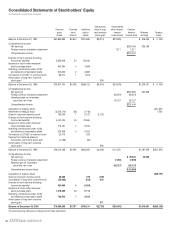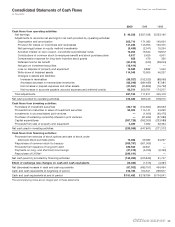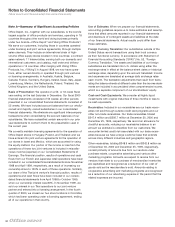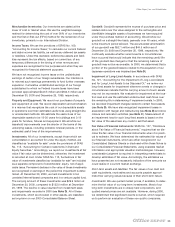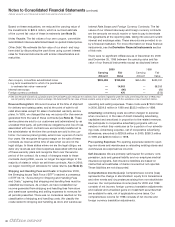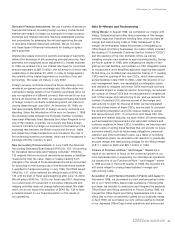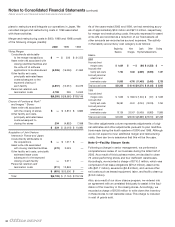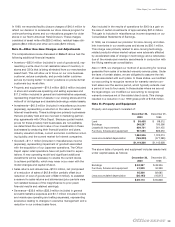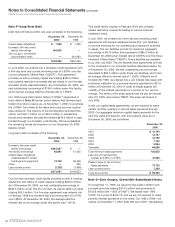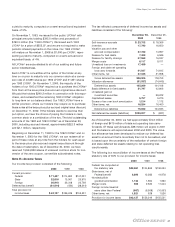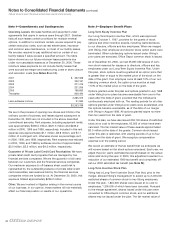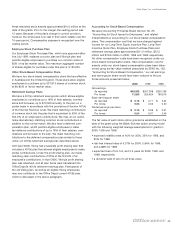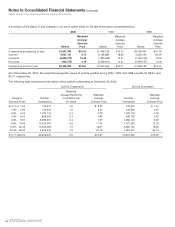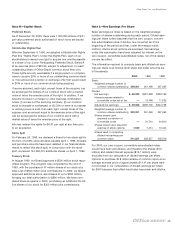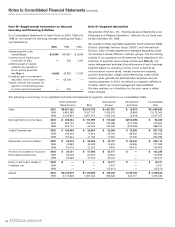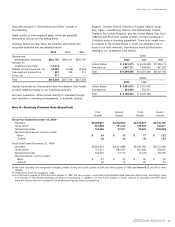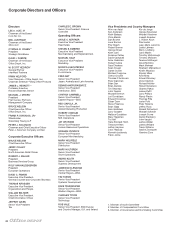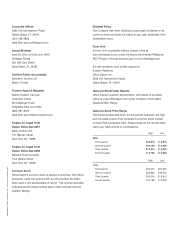Office Depot 2000 Annual Report Download - page 44
Download and view the complete annual report
Please find page 44 of the 2000 Office Depot annual report below. You can navigate through the pages in the report by either clicking on the pages listed below, or by using the keyword search tool below to find specific information within the annual report.
42
Notes to Consolidated Financial Statements (continued)
(Tabular amounts are in thousands except share and per share amounts)
Note I—Commitments and Contingencies
Operating Leases: We lease facilities and equipment under
agreements that expire in various years through 2021. Substan-
tially all such leases contain provisions for multiple renewal
options. In addition to minimum rentals, we are required to pay
certain executory costs, such as real estate taxes, insurance
and common area maintenance, on most of our facility leases.
We are also required to pay additional rent on certain of our
facility leases if sales exceed a specified amount. The table
below shows you our future minimum lease payments due
under non-cancelable leases as of December 30, 2000. These
minimum lease payments do not include facility leases that
were accrued as merger and restructuring costs or store closure
and relocation costs (See Notes B and C).
2001 $ 352,328
2002 322,181
2003 271,476
2004 221,206
2005 188,692
Thereafter 929,490
2,285,373
Less sublease income 21,585
$2,263,788
We are in the process of opening new stores and CSCs in the
ordinary course of business, and leases signed subsequent to
December 30, 2000 are not included in the above described
commitment amounts. Rent expense, including equipment rental,
was approximately $393.5 million, $321.5 million and $249.2
million in 2000, 1999 and 1998, respectively. Included in this rent
expense was approximately $1.1 million, $0.8 million, and $1.1
million of contingent rent, otherwise known as percentage rent,
in 2000, 1999, and 1998, respectively. Rent expense was reduced
in 2000, 1999, and 1998 by sublease income of approximately
$3.0 million, $3.2 million, and $4.0 million, respectively.
Guarantee of Private Label Credit Card Receivables: We have
private label credit card programs that are managed by two
financial services companies. We are the guarantor of all loans
between our customers and the financial services companies.
Our maximum exposure to off-balance sheet credit risk is
represented by the outstanding balance of private label credit
card receivables, less reserves held by the financial services
companies which are funded by us. At December 30, 2000, this
exposure totaled approximately $239.2 million.
Other: We are involved in litigation arising in the normal course
of our business. In our opinion, these matters will not materially
affect our financial position or results of our operations.
Note J—Employee Benefit Plans
Long-Term Equity Incentive Plan
Our Long-Term Equity Incentive Plan, which was approved
effective October 1, 1997, provides for the grants of stock
options and other incentive awards, including restricted stock,
to our directors, officers and key employees. When we merged
with Viking, their employee and director stock option plans were
terminated. When outstanding options issued under Viking’s
prior plans are exercised, Office Depot common stock is issued.
As of December 30, 2000, we had 55,807,052 shares of com-
mon stock reserved for issuance to directors, officers and key
employees under our Long-Term Equity Incentive Plan. Under
this plan, stock options must be granted at an option price that
is greater than or equal to the market price of the stock on the
date of the grant. If an employee owns at least 10% of our out-
standing common stock, the option price must be at least
110% of the market price on the date of the grant.
Options granted under this plan and options granted in July 1998
under Viking’s prior plans become exercisable from one to five
years after the date of grant, provided that the individual is
continuously employed with us. The vesting periods for all other
options granted under Viking’s prior plans were accelerated, and
the options became exercisable, as of the date of our merger
with Viking in August 1998. All options granted expire no more
than ten years from the date of grant.
Under this plan, we have also issued 236,193 shares of restricted
stock at no cost to the employees, 63,565 of which have been
canceled. The fair market value of these awards approximated
$3.0 million at the date of the grants. Common stock issued
under this plan is restricted, with vesting periods of up to four
years from the date of grant. We recognize compensation
expense over the vesting period.
We record an estimate of the tax benefit that we anticipate we
will receive based on the stock options exercised. Each year, we
adjust the prior year’s estimated tax benefit based on the actual
stock sold during the year. In 2000, this adjustment resulted in a
reduction of our estimated 1999 tax benefit and completely off-
set our 2000 estimated tax benefit (see Note M).
Long-Term Incentive Stock Plan
Viking had a Long-Term Incentive Stock Plan that, prior to the
merger, allowed Viking’s management to award up to 2,400,000
restricted shares of common stock to key Viking employees.
Under this plan, 1,845,000 shares were issued at no cost to
employees, 1,200,000 of which have been canceled. Pursuant
to the merger agreement, shares issued under this plan were
converted to Office Depot common stock, and no additional
shares may be issued under the plan. The fair market value of


